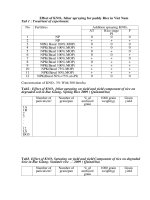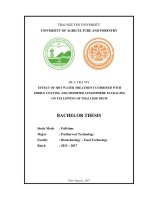Effect of total mixed ration feeding with roughage: Concentrate ratio of 60:40 on performance and residual feed intake of crossbred cows
Bạn đang xem bản rút gọn của tài liệu. Xem và tải ngay bản đầy đủ của tài liệu tại đây (156.83 KB, 5 trang )
Int.J.Curr.Microbiol.App.Sci (2019) 8(4): 2866-2870
International Journal of Current Microbiology and Applied Sciences
ISSN: 2319-7706 Volume 8 Number 04 (2019)
Journal homepage:
Original Research Article
/>
Effect of Total Mixed Ration Feeding with Roughage: Concentrate Ratio of
60:40 on Performance and Residual Feed Intake of Crossbred Cows
Jyoti Sumer Kajla1, R.S. Grewal1*, Jasmine Kaur1, J.S. Lamba1,
Simarjit Kaur2 and PuneetMalhotra2
1
Department of Animal Nutrition, GADVASU, Ludhiana, India
Directorate of Livestock Farms, GADVASU, Ludhiana, India
2
*Corresponding author
ABSTRACT
Keywords
Total mixed ration,
RFI, Roughage:
concentrate ratio
Article Info
Accepted:
20 March 2019
Available Online:
10 April 2019
High yielding crossbred cows are fed high amount of concentrate which poses metabolic
disorders. TMR feeding is suitable for high concentrate feeding. RFI is a measure of
efficiency which has not been explored in crossbred cows. Therefore present study was
undertaken to study the effect of TMR feeding of performance and RFI in crossbred cows.
Twelve cows were divided in to two groups of six animals each and fed ration with 60:40
roughage: concentrate ratio. The animals were fed individually and daily feed intake and
refusal were recorded. The DM intake was calculated. The data showed that the DM intake
of was similar in both the groups. On DMI basis, RFI, when calculated on DMI basis, was
significantly (P <0.05) lower in TMR as compared to NON-TMR. The digestibility of DM,
CP, ADF, NDF and TDN was significantly (P <0.05) higher in TMR as compared to
NON-TMR. The TMR feeding had significantly positive (P <0.05) effect on milk
production, and milk energy yield. The RFI had negative correlation with intake and
digestibility parameter of ration.
Introduction
The feeding system based on TMR is ideal for
the high yielding dairy animals because when
fed high concentrate ration these animals are
prone to metabolic disorder like acidosis,
lameness etc. These problems could be
minimized or totally eliminated when feeding
is done as TMR. Residual feed intake can be
calculated by measuring an animal’s actual
feed intake and estimating what the animal
should be eating based on gain and
production. Estimated feed intake is then
subtracted from actual feed intake. Genetic
selection to reduce RFI can result in progeny
that eat less without sacrificing performance
(Herd et al., 1997 and Richardson et al.,
1998). There are not many studies on TMR
feeding and RFI in crossbred cows.
Therefore, present experiment is planned to
study the effect of TMR feeding on
performance and RFI of lactating crossbred
cows.
Materials and Methods
The concentrate was prepared for formulating
TMR as per table 1. The TMR consisted of
2866
Int.J.Curr.Microbiol.App.Sci (2019) 8(4): 2866-2870
concentrate- 7 kg, wheat straw-2 kg and nonlegume silage-36 kg (adjusted weekly on DM
basis).
The experiment was conducted at Guru
Angad Dev Veterinary and Animal Sciences
University, Ludhiana. Twelve cows were
divided in to two groups of six animals each
and fed ration with 60: 40 roughage:
concentrate ratio. The animals were fed
individually and daily feed intake and refusal
was recorded. The DM, OM, CP, NDF, ADF,
EE and energy intakes were calculated. The
cows were stall fed throughout the
experimental period. Fresh and clean water
was provided thrice a day i.e. morning,
afternoon and evening throughout the
experimentation. Proper hygienic conditions
and healthy surrounding were maintained in
the shed throughout the experimental feeding
period. During the research period, health
status of cows was monitored regularly. This
feeding experiment was of 45 days duration
The sample of feed and refusal were taken
twice weekly for analysis for proximate
principles (AOAC 2000) and cell wall
fractions (VanSoest, 1963). The body weight
of animals was recorded fortnightly. The milk
was measured daily and milk composition
was estimated at weekly intervals. Residual
feed intake estimation was measured by the
method given by (Koch et al., 1963). The
estimated intakes was calculated from
regression of actual intake energy yielded in
milk MJ/d (LE) and live body weight changes
(expressed per unit metabolic body size
defined as LW) and the fitted values taken as
estimated intakes (Veerkamp et al., 1995).
Actual intakes were regressed on milk yield,
milk energy yield and the two way interaction
between milk yield (MY) and live weight
change (LWC). The actual ME intake and
predicted ME intake were also estimated. The
correlations of RFI with various animal and
dietary parameters were calculated.
Experimental feeds offered to crossbred
cows in different groups
Experimental
group
NON-TMR
TMR
Experimental feed
Silage + Wheat straw + concentrate
without mixing
Silage + Wheat straw + concentrate
with proper hand mixing
A digestion trial was conducted for 7 days on
all experimental cows after 50 days of feeding
trial. Collection of feaces was done on 24
hourly basis. Simultaneously daily feed
offered and residue left was recorded. The
representative samples of feed offered,
residue left and feaces voided were collected
and analyzed for proximate principles by the
methods of (AOAC 2000) in order to
determine the digestibility of different
nutrients viz. dry matter, crude protein, ether
extract, total ash, ADF and NDF.
Results and Discussion
The data showed that the DM intake was
similar in both the groups. On DMI basis,
RFI, when calculated on DMI basis, was
significantly (P <0.05) lower in TMR as
compared to NON-TMR (Table 2).
Data revealed that the digestibility of DM,
CP, ADF, NDF and TDN % was significantly
(P <0.05) higher in TMR as compared to
NON-TMR, however, mode of feeding had
no significant effect on OM, EE and CHO
digestibility (Table 2). Raja Kishore et al
(2013) reported similar results. They found
that the DM intake (kg/d) was similar in TMR
and non-TMR groups in buffalo bulls. They
found that the digestibility (%) of CP, EE, CF,
NDF, ADF, hemi-cellulose and cellulose were
higher (P < 0.01) in animals fed complete
rations than those fed conventional ration.
The data pertaining to effect of mode of
feeding as TMR or NON-TMR on ilk
2867
Int.J.Curr.Microbiol.App.Sci (2019) 8(4): 2866-2870
production and composition in low
concentrate group is given in table 3. The
TMR feeding had significantly positive (P
<0.05) effect on milk production, and milk
energy yield. However, the milk protein %
was significantly (P <0.05) higher in NONTMR as compared to TMR.
This might be due to some sorting of feed
ingredients taking place in NON-TMR group.
TMR and NON-TMR had no significant
effect on milk/kg MBW, fat %, fat yield,
protein yield and FCM. Gupta et al (2014)
found overall average increase in milk
production by 18.22% in cows fed TMR.
They concluded that feeding of TMR is
beneficial for proportionate intake of all feed
ingredients, overall feed intake and better
digestibility of nutrients resulting into higher
milk production. Schraufnagel (2007) also
reported that TMR has a positive effect on
milk yield and profits. Similar results are
reported by Bargo et al., (2002).
The RFI had negative correlation with intake
and digestibility parameter of ration (Table 4).
Richardson and Herd (2004) also found
negative correlation between RFI and
digestibility.
They performed a divergent selection
experiment for residual feed intake in Angus
beef cattle progeny to help determine
mechanisms underlying the variation in RFI.
They found a correlation of -0.44 between
RFI and digestibility.
Table.1 Composition of TMR fed to animals
Parameter
OM
CP
NDF
ADF
EE
Ash
Composition, % DM
91.47
14.34
42.61
25.86
3.06
8.53
Table.2 Effect of TMR or NON-TMR ration on intake, nutrient digestibility and RFI
Parameter
DMI, kg/day
Digestibility coefficient %
DM
OM
CP
EE
NDF
ADF
CHO
TDN %
RFI, kg/day(DM)
TMR
17.50
NON TMR
17.45
SE
0.06
p value
0.33
65.76
70.26
69.64
80.42
60.24
65.86
63.04
64.59
-2.69
61.88
71.25
66.72
78.35
52.80
63.67
61.33
62.06
1.07
1.30
0.77
1.23
1.04
2.40
0.86
0.99
1.07
0.01
0.001
0.37
0.05
0.06
0.001
0.03
0.12
0.04
0.03
2868
Int.J.Curr.Microbiol.App.Sci (2019) 8(4): 2866-2870
Table.3 Effect of TMR or NON-TMR ration on Milk production and composition
Parameter
Milk yield kg/day
Milk/kg MBW
Milk energy yield, MJ/day
Fat %
Fat yield kg/day
Protein %
Protein yield kg/day
FCM kg/day
RFI
TMR
14.81
0.53
45.96
3.69
0.55
3.00
0.44
14.86
- 1.36
NON-TMR
12.02
0.50
40.92
3.77
0.45
3.11
0.37
13.16
1.14
SE
0.77
1.45
1.91
0.18
0.03
0.08
0.04
1.25
0.45
p valve
0.05
0.20
0.02
0.38
0.09
0.04
0.21
0.10
0.001
Table.4 Correlation of RFI with different intake and digestibility parameter
Parameter
DMI kg/day
OMD
DMD
AFMD
NDFD
EED
ME INTAKE MJ/day
NE INTAKE MJ/day
In conclusion, TMR and NON-TMR had nonsignificantly effect on intake parameter.
Nutrient digestibility is significantly (p<0.05)
higher for DM, CP, EE, ADF, NDF and TDN
in TMR compared to NON-TMR rations. The
TMR had significantly (p<0.05) positive
effect on milk yield, milk energy yield and
FCM yield. TMR had significantly (p <0.05)
lower RFI as compared to NON-TMR
indicating better efficiency in TMR groups.
The correlation of RFI with DMI, OMD,
DMD, AFMD, EED, NDFD, MEI, NEI was
negative.
References
AOAC. 2000. Official Method of Analysis
(17th ed.) Association of Official
Analytical Chemists, Inc., Maryland,
USA.
Correlation
-0.27
-0.78
-0.84
-0.68
-0.61
-0.56
-0.85
-0.85
Bargo, F., Muller L D., Delahoy J E and
Cassidy T W. 2002. Performance of
high producing dairy cows with three
different feeding systems combining
pasture and total mixed rations.
Journal of Dairy Science 85(11):
2948-63.
Herd, R M., Archer J A, Arthur P F,
Richardson E C, Wright J H, Dibley K
C P and Burton D A. 1997.
Performance of progeny of high vs.
low net feed conversion efficiency
cattle.
Association
for
the
Advancement of Animal Breeding and
Genetics12: 742-45.
Koch, R M., Swiger, L A., Chambers D and
Gregory K E. 1963. Efficiency of feed
use in beef cattle. Journal of Animal
Sciences 22: 486-94.
Raja Kishore, K., Srinivas Kumar, D., and
2869
Int.J.Curr.Microbiol.App.Sci (2019) 8(4): 2866-2870
Ramana J V. 2013. Effect of feeding
crop residue based complete rations on
nutrient utilization in buffalo bulls.
International Journal of Agriculture
Science and Veterinary Medicine
Richardson, E.C., and Herd, R.M., 2004.
Biological basis of variation in
residual feed intake in beef cattle. 1.
Review of potential mechanisms.
Australian Journal of Experimental
Agriculture 44: 423-30.
Schraufnagel, S., 2007. Technology Systems
and Business Performance on
Wisconsin Dairy Farms. University of
Wisconsin-River Falls.
Van Soest, P.J., 1963. Ruminant fat
metabolism with particular reference
to factors affecting low milk fat and
feed efficiency: Review Article.
Journal of Dairy Science 46: 204-16.
Veerkamp, R., and Emmans G C., 1995.
Sources of genetic variation and
efficiency of dairy cows. Livestock
Production Science 44: 87-97.
How to cite this article:
Jyoti Sumer Kajla, R.S. Grewal, Jasmine Kaur, J.S. Lamba, Simarjit Kaur and PuneetMalhotra.
2019. Effect of Total Mixed Ration Feeding with Roughage: Concentrate Ratio of 60:40 on
Performance and Residual Feed Intake of Crossbred Cows. Int.J.Curr.Microbiol.App.Sci.
8(04): 2866-2870. doi: />
2870









